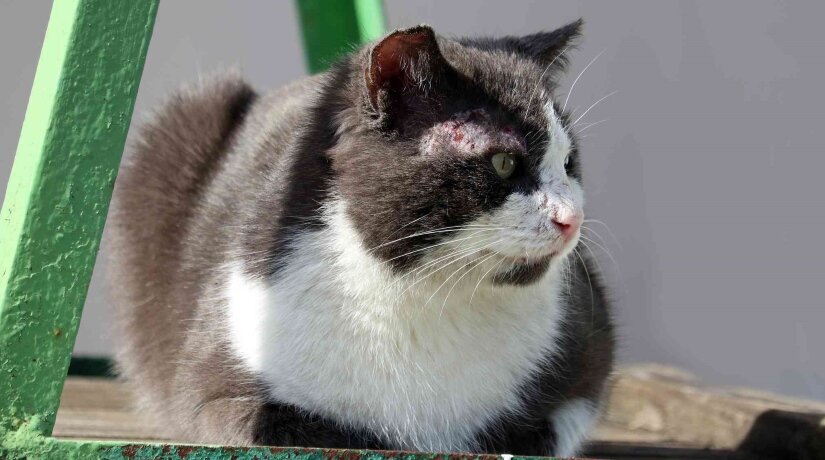Cats can become affected by skin diseases, also known as dermatopathies at any time. Parasites, allergies, allergens, bacterial, viral, parasitic, or fungal infections, and even hormonal imbalances, and tumors can trigger off a skin disorder.
Cats that are already on a flea preventative should be tested for atopy, so that a specific diagnosis and treatment is made by a veterinarian.
Cat Skin Conditions
The most common skin disorders are caused by fleas, followed by inhaled allergens like tree and grass pollen, and even indoor mold spores. You’ll have to get a veterinary diagnosis fast, so as to help your cat with painful excessive itching, pain, and to also prevent hair loss and hot spots.
Your cat’s lifestyle, gender, and breed will also determine how prone your cat is to various skin disorders. There are also certain cat breeds like the Himalayan that are more prone to skin disorders.
Dermatitis in cats is pretty common, and you should bring your cat to the veterinarian, to identify and resolve the underlying cause, and treat the infection.
Studies from Cornell College of Veterinary Medicine indicate that “ between 6 and 15 percent of feline patients have at least one dermatopathy and many cats suffer from more than one. Among cats presented to the dermatology service at the Cornell University Hospital for Animals, for instance, a recent study showed that 22 percent had evidence of two skin diseases and 6 percent have three distinctive skin diseases.”
With the skin being the largest organ of your cat’s body, it’s important to note any changes when grooming your cat. Small issues can turn into larger ones quickly when it comes down to skin disorders in pets. So let’s take a look at the function of the skin. What does it do?
- Forms a protective barrier against the environment
- Regulates temperature
- Gives your cat a sense of touch
- The skin can take up as much as 12-24% of a cat’s body weight. This will differ according to the species and age of the cat
The skin has three layers, the epidermis (outer layer), the dermis (middle layer), and the sub cutis, which is the innermost layer. Parasites, and other common causes of skin diseases will vary according to the geographic location.
According to a Cornell study “the most common causes of skin disease in cats seen by dermatology specialists are allergies to airborne particles, food, or flea and mosquito bites. At private practices in Canada and the United Kingdom, on the other hand, studies show that abscesses are the most common cause of skin disease in feline patients.”
Clinical Signs
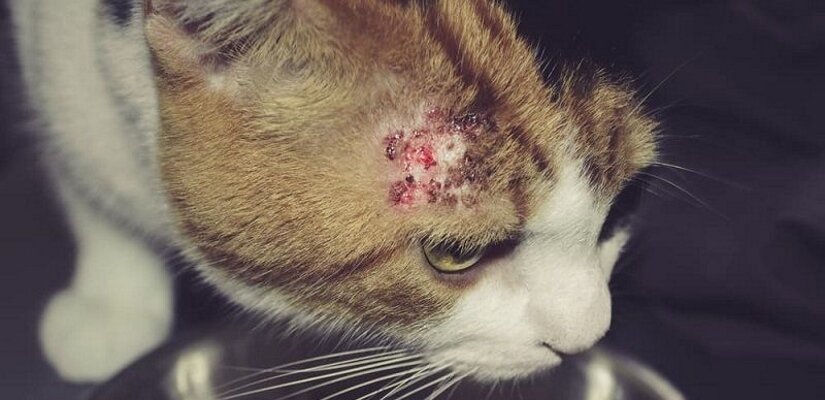
Today, our cats face a variety of skin disorders that can occur at any time. Some skin diseases may be seasonal. There may be ticks, fleas and mites present. Your furry best friend may also be affected by a change in the environment, grass, or even mold spores. The most common areas affected in cats is the neck, face, abdomen, top of the body, and tail base.
Flea, environmental, and food allergies are the most common issues with domesticated cats. Fortunately, it’s easy to see if your cat has a skin condition. With that said, when you notice the beginning of inflammation, redness, or even crustiness on your cat’s skin, you should immediately consult with your veterinarian. This is because something small can turn into a bacterial infection very quickly. Skin disorders are not only painful, but can result in hair loss as well. If you notice these signs, it’s time to visit your veterinarian.
- Excessive itching of the ear (mites, food allergies, hormonal imbalance)
- Scaling
- Chewing of the skin
- Chronic inflammation
- Redness
- Fluid discharges like pus
- Small or large bumps on the skin
- Scratching of the outside of the ear (immune issue, skin allergies, scabies, inflammation of blood vessel caused by a virus, allergies, and food allergies)
- Head shaking, scratching of the ear, face (fleas, ear mites, mange, food allergies, fungal infection, food allergies)
- Scratching and licking of the paws (food allergy, mange, atopy, fungal infection, and insect allergy)
If you look at the most common areas affected by excessive skin scratching in cats, you’ll notice that many overlap. With that said, it’s most important to consult with your veterinarian as soon as you notice excessive scratching. Inflammation with a secondary bacterial infection occurs fast, and you’ll find that your furry best friend is losing hair, and has painful, inflamed skin that may be crusty. The longer that you delay veterinary treatment, the longer it will take to treat.
Diagnosis
Your vet will take down a detailed history, do a physical examination, and take the necessary diagnostic tests. Some skin diseases have similar signs, so your vet will have to run several lab tests, thus making an immediate diagnosis not possible. Testing via lab procedures may entail the following:
- Microscopic analysis of skin scrapings and hair
- Blood and urine tests
- Biopsies
- Cultures of skin swabs
Allergic Dermatitis

Flea Allergy
There’s nothing more annoying and painful than excessive itching and skin irritations for cats. Today, with the use of effective parasite control and conventional pet meds, prevention and treatment is more effective and safer.
Additionally, you can purchase safe flea preventatives that are natural without side effects. This will reduce the chances and the severity of a flea infestation. You should always consult with your veterinarian who will be able to recommend the most suitable flea preventative for your cat.
The American Veterinary Medical Association (AVMA) explains that “Because much of the flea’s life cycle is spent off of your pet, treating only your pet will not eliminate the problem. If you kill the adult fleas and do not kill the eggs, larvae and pupae, your pet will become re-infested when these fleas become adults and the cycle will start all over again.”
Environmental Allergy
Airborne allergies take place when cats are exposed to environmental allergens like pollen, mold spores or dust mites. The key to minimizing this is to remove or restrict exposure to the allergen. This could even be a contact allergen in the home. Airborne allergens can be seasonal or non-seasonal. Cats that are affected will have abnormal sensitivities to the air that they breath in, or contact environmental allergen issues.
Airborne allergies result in excessive itching, and cats that are affected will usually scratch and lick excessively. This results in sores and other skin conditions like scaling, hair loss, excessive redness, and crusting with inflammation.
Food Allergy
If your cat is allergic to a food ingredient, this will also usually result in excessive scratching and licking. Symptoms are similar as to those affected with airborne allergies, with food allergy itching being specifically directed at the head and face area in cats.
Walking Dandruff
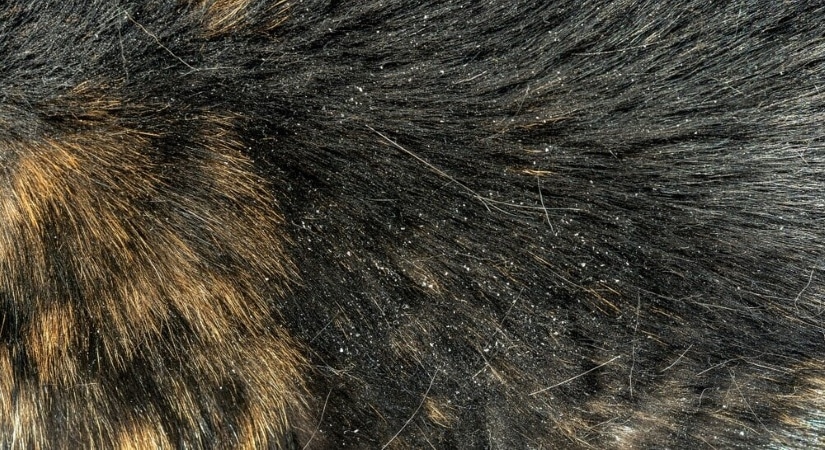
With walking dandruff, the ear mites move along the cat’s skin, and these multiply quickly in a household, and are contagious. They have a 3-week life cycle on cats, and cause skin infestations with scaling and intense itching. This can result in crusting along the back area, with many small bumps along a cat’s back.
Cat Scabies/Mange
This is caused by mites, and is contagious. These mites are microscopic and invade the skin of healthy cats. Mite infestations also result in hair loss, itching and inflammation. All cats are prone to mites, even domesticated cats that live indoors.
Tumors
There’s nothing more frightening than feeling a bump on your cat. Tumors that affect the skin or tissue under the skin are the most common tumors in cats. There are a few reasons for this. The first being that they are most easily noticed because the skin is exposed to many cancer-causing factors like chemical carcinogens, solar radiation, and viruses. There are also genetic and hormonal factors at play with tumors in cats. Visit your vet at the first sign of a lump or bump. If it’s serious, you could be saving your cat’s life.
Ear Mites
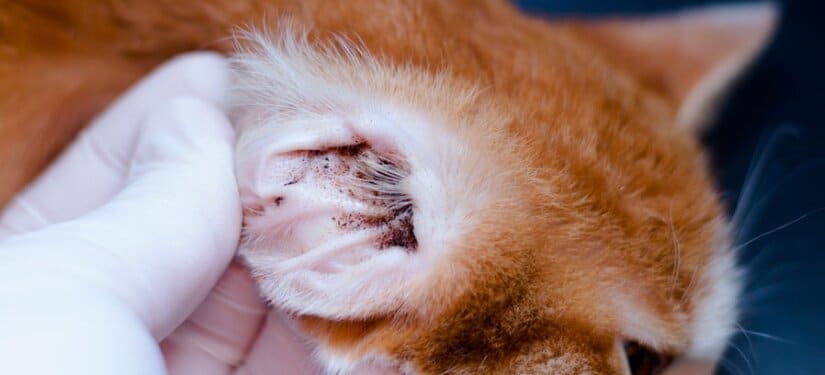
Ear mites infest the external ear, and inflame the ear canal. This is common in cats, and you’ll see lots of itching, pain, and head shaking.
Skin Cysts
Some cysts develop that are filled with keratin, a skin protein. These are benign, and have a hard or solid core. Most of these cysts are malformations of hair follicles, and may be the same color as the hair. There is sometimes more than one cyst, and your veterinarian will usually remove them.
Treatments
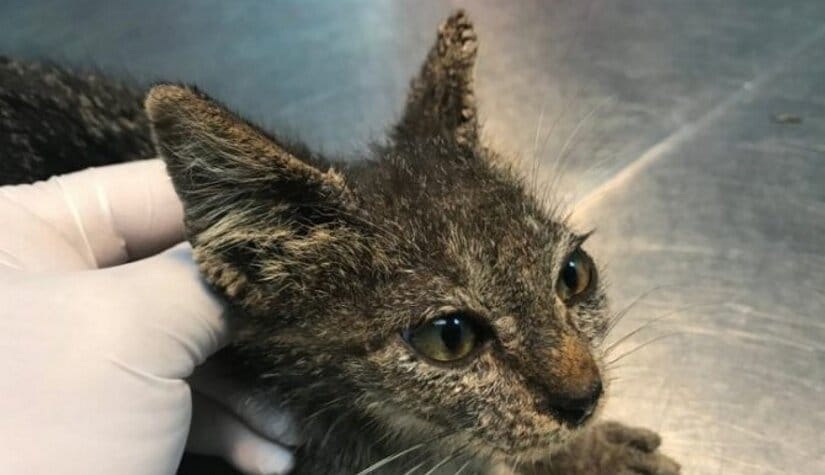
Treatment will depend on the diagnosis, and may range from antibiotic ointments, corticosteroid preps, topical insecticides, and even medicated shampoos. Because most cats don’t enjoy being bathed, washing the affected areas only, may be recommended. Systemic drugs are also used to treat some skin disorders.
Cats with flea and environmental allergies may also do well with homeopathic and herbal remedies for flea allergies. You’ll also need to vacuum frequently to get rid of flea larvae and eggs in your home, and to use a flea comb.
Antibiotics, corticosteroids, and other inflammatory drugs may be used. It’s important that you use these properly, and understand how to apply them, give cats the correct dosage, and so forth. If you don’t understand the directions, consult with your veterinarian.
If your furry best friend has a food allergy, your vet will develop a specific test plan for your cat, and will try out the food elimination diet. This has to be done correctly and together with your veterinarian.
You’ll need to keep in mind that flea allergies look similar to infestations with other skin parasites like ringworm infection, hair follicle infections, and even medication sensitivities.
Discuss flea control with your veterinarian to find a good flea preventative that works well for your individual cat, that is effective for the area that you live in. If your cat suddenly starts grooming excessively, scratching, and itching, he may be suffering from a skin disorder.
